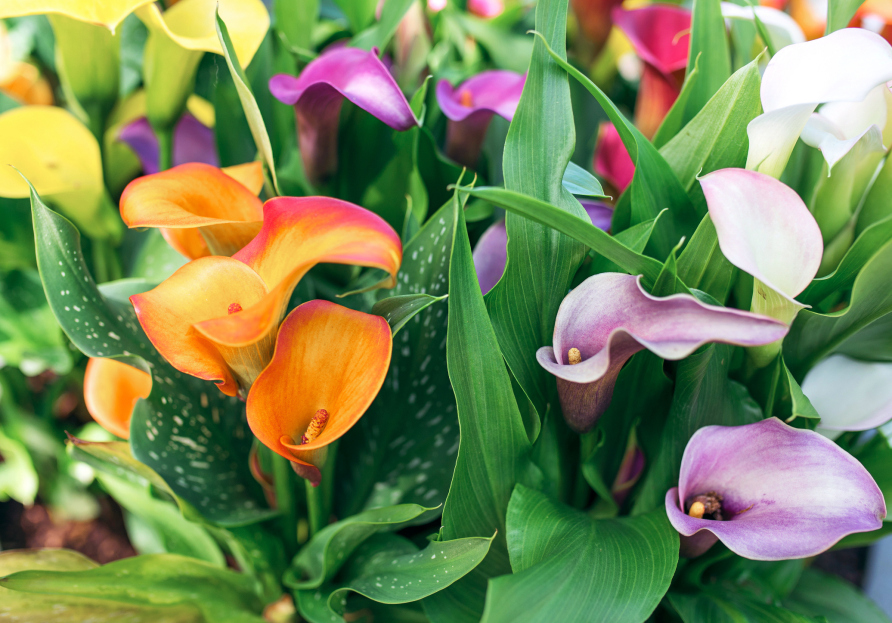
Calla Lilies, with their sleek, trumpet-shaped blooms and vibrant colours, make stunning indoor plants. Their elegant appearance adds a touch of sophistication to any room, and with the right care, they can thrive indoors all year round. Here’s a detailed guide to help you care for Calla Lily plants indoors.
Calla Lilies require bright, indirect light to thrive indoors. Place your plant near a window that gets plenty of sunlight, but avoid direct sun, which can scorch the leaves.
If your home doesn’t get much natural light, you can use a grow light to provide the necessary illumination. Aim for about 6-8 hours of light daily.
Keep the soil consistently moist but not over saturated. Water your plant when the top inch or two of its soil feels dry to the touch. Be careful not to overwater, as this can lead to root rot. When watering into a pot without drainage holes, be sure to discard any excess water sitting in the outer pot to avoid root rot.
In the winter, when the plant’s growth slows down, reduce watering slightly but don’t let the soil dry out completely.
Calla Lilies prefer a humid environment, which can be a challenge indoors, especially in winter. To maintain humidity, you can mist the plant regularly or place a humidifier nearby.
Keep the temperature between 60-75°F (15-24°C). Avoid placing your plant near cold or hot drafts, heating vents, or air conditioners, as sudden temperature changes can stress or kill your plant.
During the growing season (spring and summer), feed your Calla Lily with a balanced, water-soluble fertilizer every 4-6 weeks. This will encourage healthy growth and vibrant blooms.
You can stop or reduce fertilizing during the fall and winter when the plant’s growth slows down.
Remove any yellowing or wilted leaves to keep the plant looking its best. This also helps prevent disease and encourages new growth.
After the flowering period, the plant may go dormant. If this happens, cut back the foliage, reduce watering, and allow the plant to rest for a few months. Resume regular care when new growth appears.
Calla Lilies can be propagated by dividing their rhizomes, which is best done in the fall after the plant has gone dormant. To propagate, carefully dig up the plant, clean the rhizomes, and use a sharp knife to divide them into sections, ensuring each piece has at least one growing eye and some roots.
Plant the divided rhizomes in well-draining soil, either in pots or directly in the garden, with the eye facing up. Water lightly and keep in a location with bright, indirect light. With proper care, the new plants will establish themselves and eventually bloom.
Calla Lilies prefer to be slightly root-bound, so they don’t need to be repotted often. However, if the roots start to outgrow the pot or if the plant becomes top-heavy, it’s time to repot.
Repot in the spring, just before the growing season begins. Choose a pot that’s one size larger and refresh the soil to give your plant a nutrient boost.
Soil: Use well-draining potting soil rich in organic matter. A mix of regular potting soil with some peat moss or compost is ideal for Calla Lilies. The soil should be slightly acidic to neutral, with a pH between 6.0 and 6.5.
Pot: Start by selecting a pot with drainage holes to prevent water from accumulating at the bottom, which can lead to root rot. A pot that is slightly larger than the root ball of the plant will give it space to grow.
Indoor Calla Lilies can be susceptible to pests like aphids, spider mites, and mealybugs. Regularly check the leaves for signs of infestation and treat promptly with insecticidal soap or neem oil if necessary.
Prevent fungal diseases by ensuring good air circulation around the plant and avoiding water on the leaves.
To encourage blooming, make sure your Calla Lily gets enough light and nutrients. If your plant isn’t blooming, it may need a rest period. Allow it to go dormant by reducing watering and letting it rest in a cool, dark place for a couple of months. After this period, resume regular care, and you should see new growth and blooms.
Unfortunately, calla lilies are not safe for pets. These plants contain calcium oxalate crystals, which can cause irritation and toxicity if ingested by cats or dogs.